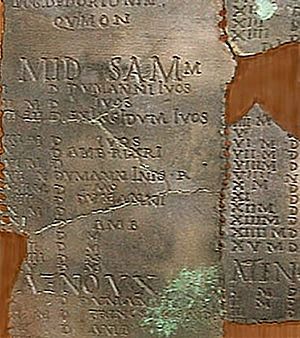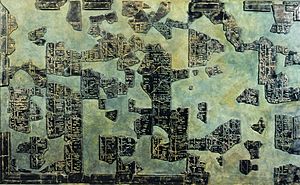Coligny calendar facts for kids
The Coligny calendar is a very old Celtic calendar from Roman times. It was found near Lyon, France, in 1897. This special calendar was made of bronze. Today, only pieces of it are left. Scientists studied these pieces and found that they formed a Gallic calendar. It was designed to keep track of time for five years. The Coligny calendar shows both the solar year (like our modern calendar) and the phases of the moon. This type of calendar, which uses both the sun and moon, is called a lunisolar calendar.
This ancient calendar was carved onto a large bronze tablet. It was originally about 1.48 meters (5 feet) wide and 0.9 meters (3.5 feet) high. Today, it is preserved in 73 pieces.
Based on its style, experts believe it was made around the end of the 2nd century AD. The calendar is written in Latin letters. However, the language used is Gaulish, which was spoken by the people of Gaul. When put back together, the tablet has sixteen tall columns. These columns show 62 months spread out over five years.
Why Was the Coligny Calendar Made?
A French archaeologist named J. Monard thought that druids might have made this calendar. Druids were important religious leaders among the Celts. They might have wanted to keep their traditional way of telling time. This was important because the Julian calendar was being introduced across the Roman Empire.
However, the calendar's general look is similar to public calendars. These were called parapegmata and were found throughout the Greek and Roman world. They often had pegs to mark the days.
Other Ancient Calendars
Another similar calendar was found nearby in a place called Villards d'Heria. Only eight small pieces of this calendar remain. It is now kept in the Musée d'Archéologie du Jura in Lons-le-Saunier, France.
Images for kids
See also
 In Spanish: Calendario de Coligny para niños
In Spanish: Calendario de Coligny para niños






